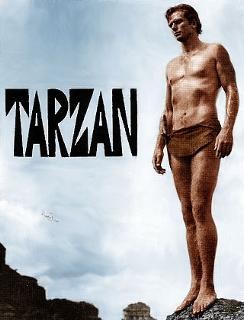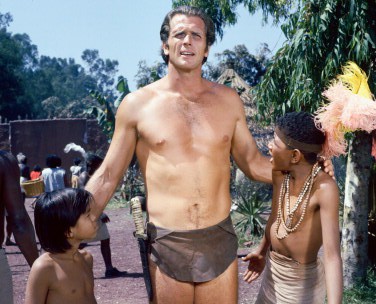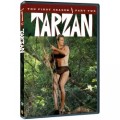| Reviews & Columns |
|
Reviews DVD TV on DVD Blu-ray 4K UHD International DVDs In Theaters Reviews by Studio Video Games Features Collector Series DVDs Easter Egg Database Interviews DVD Talk Radio Feature Articles Columns Anime Talk DVD Savant Horror DVDs The M.O.D. Squad Art House HD Talk Silent DVD
|
DVD Talk Forum |
|
|
| Resources |
|
DVD Price Search Customer Service #'s RCE Info Links |
|
Columns
|
|
|
Tarzan - Season One - Part Two
First, a bit of history is in order: The Tarzan film series appeared to have run its course by the mid-1960s, when Tarzan the television series made its 1966 debut. The official film series got off to a good start in 1932, with Tarzan the Ape Man, famously starring Johnny Weissmuller, five-time Olympic Gold Medal-winning swimmer. The next film, Tarzan and His Mate (1934), remains a pre-Code masterpiece, a picture as exciting, innovative, violent, and sexually explicit (more so in the latter case) as the contemporaneous but more widely remembered King Kong (1933). The third film, Tarzan Escapes (1936), might have been its equal, but that one was heavily edited and reworked after audiences found much of it too intensely horrifying.*
After that, MGM wholesomeness quickly seeped in, seriously undercutting what had come before, particularly in Tarzan Finds a Son! (1939) and Tarzan's New York Adventure (1941). Tarzan's Secret Treasure (released earlier in 1941) is somewhat better, and might have been great had the original ending, in which Tarzan's love Jane (Maureen O'Sullivan) was to have tragically died, been retained. (Weissmuller's moving performance for this scene was basically retained, however.)
While no great actor, Weissmuller nonetheless was a great Tarzan. His was a monosyllabic character with a deep distrust, usually justified, of "civilized" man. He was uncompromising and unhesitatingly violent when he needed to be, but he treasured his freedom and his animal friends, while Jane, with whom he had the most overtly sexual relationship among 1930s and '40s Hollywood characters, further humanized him. (O'Sullivan's Jane was cultured but sexy, at least at first, while Brenda Joyce's equally fine Jane in the later films was intuitive and sensitive yet assertive toward her common- [jungle-] law husband.)
From here Weissmuller and Tarzan moved over to RKO, in films considered slightly inferior, but which this reviewer vastly prefers to the later MGM ones. Like other Hollywood stars, Tarzan fought Nazis for a couple of years, but then returned to more traditional, sometimes fantasy-laced adventures. As with the first two MGMs, the RKO Tarzans had moments bordering on poetry. In one film, ruthless hunters across the river from Tarzan's territory insist they have a right to slaughter as many animals as they damn well feel like. Tarzan responds with his classic jungle cry - and all of the endangered animals diligently cross the river en masse into Tarzan's domain, and safety.
Director Kurt Neumann brought a lot of style to these later Weissmullers, which were all pretty good until the last one, Tarzan and the Mermaids (1948), at which point Weissmuller hung up his loincloth and became African hunter Jungle Jim for Monogram, basically Tarzan with his clothes on.**
Lex Barker replaced him for the next five movies, from Tarzan's Magic Fountain (1949) through Tarzan and the She-Devil (1953). He was more conventionally handsome yet somehow regal, a fine Tarzan overall, and in some respects more like the Tarzan of author Edgar Rice Burroughs's novels, but he lacked Weissmuller's unspoiled innocence. The series, still at RKO, was generally good, though dipping slightly if steadily throughout the Barker years.
Next came bodybuilder Gordon Scott, who debuted in Tarzan's Hidden Jungle (1955) alongside future wife Vera Miles. The Gordon Scott Tarzan films were far and away the most schizophrenic. Tarzan's Hidden Jungle was much like Barker's later, cheaper ones, but the next movie, Tarzan and the Lost Safari (1957), was not only the first in color, it also was the first to be shot in England with a mostly British cast, and it featured fairly extensive second unit footage filmed in Africa.
However, the next film, Tarzan's Fight for Life (1958), made back in Hollywood, was incredibly cheap and stillborn, shot almost entirely on phony soundstage "jungle" sets. In these same spartan surroundings Scott also starred as Tarzan in an even worse unsold television pilot eventually released to television as Tarzan and the Trappers.
But then, something happened that changed the entire course of the franchise. Rights to the series were acquired by producer Sy Weintraub, and a half-century before the term "reboot" defined a completely revamped continuing film series, Weintraub did just that. Though Gordon Scott continued in the role of Tarzan, he was suddenly an educated, cultured and grimmer ape-man closer to Burroughs's original, and not limited to "Me Tarzan. You Jane" type dialog. Further, Tarzan's Greatest Adventure (1959) was filmed almost entirely on location in Kenya, and featured two formidable actors playing the villains: Anthony Quayle and relative newcomer Sean Connery. It was easily the best Tarzan movie since Tarzan and His Mate (1934).
After that Scott made just one more, Tarzan the Magnificent (1960), but that was nearly as good and featured stuntman and actor Jock Mahoney as an equally vile, memorable villain. However, as popular as Scott was and as good as his last two entries were, Scott himself was a limited actor and for all his muscles had a boyish face not really suited to more adult, darker Tarzan envisioned by Weintraub. When Mahoney took over the part for Tarzan Goes to India (1962) that actor was already 42 years old, the oldest rookie Tarzan ever. Further, while athletic he was lanky and a startling contrast to Scott, his leanness stretched further by illness while on location, where he lost even more weight.
But Mahoney proved the best Tarzan since Weissmuller, and so different that comparisons are pointless. His was a more world-weary, experienced Tarzan than Scott's, instead more like the John Wayne of She Wore a Yellow Ribbon or The Man Who Shot Liberty Valance, or the outcast Wayne played in The Searchers. Mahoney's two Tarzans, Tarzan Goes to India and Tarzan's Three Challenges are superb. Featuring spectacular, almost other-worldly locations (in India and Thailand), large-scale action set pieces, and rich, sometimes even unexpectedly moving characterizations, they represent the post-Weissmuller Tarzan series at its peak, even over the more widely acclaimed Tarzan's Greatest Adventure. Although they've been released to DVD via Warner Archive's MOD program, they're really ripe for rediscovery and a Criterion Collection-type remastering loaded with extra features.
After nearly dying while making Three Challenges, Mahoney left the role and was replaced by Mike Henry for the last three Tarzan movies. Tarzan and the Valley of Gold (1966) is quite good, furthering the series' James Bond-like stylings, which dated back to the pre-Bond Greatest Adventure. Like the two Mahoneys, it used its location, this time Mexico and its Teotihuacan ruins, to excellent advantage. However, Tarzan and the Great River (1967) and Tarzan and the Jungle Boy (1968), filmed back-to-back in Mexico and Brazil, were fair at best and Henry soured on the role after he was bitten in the chin by the (much too adult) chimpanzee playing Cheeta.
And so Weintraub moved Tarzan to TV.
Having released all of these films to DVD and later as MOD Warner Archive titles, the label's next obvious step was to move forward with the 1966-68 television series, and Tarzan - The First Season - Part Two does just that. Part Two offers the final 16 first season shows on four DVDs. Though being sold separate from Part One they're really a matched set: the Part Two discs are even numbered Disc 5, Disc 6, Disc 7, and Disc 8.
Tarzan the series isn't as good as the best '60s Tarzans, but for reasons discussed below it's a valiant attempt to produce movie-like television shows far superior to Hollywood, episodes quite unlike the usual Hollywood backlot adventure programs. The video transfers, while dirty and damaged (some of the dirt seems inherit to the original film elements), are otherwise sharp and bright. The shows pack a decent amount of action, and fans of the Tarzan movies should be pleased.
Ron Ely became TV's Tarzan. Like Mahoney Ely was lithe and less muscular than either Scott or Henry, and he was much younger (just 28) with handsome, sculpted, even Romanesque facial features.
Clearly, Weintraub wanted to retain as many of the same qualities of his feature films for the series, but was up against impossible odds in terms of time and money. Unusual for a prime-time network (NBC) show, it began shooting entirely on location in Brazil, flying guest stars all the way to South America. However, the logistics proved impossible and the unit relocated to Mexico, with these shows alternating between impressive location exteriors and less convincing studio interiors and, sometimes, jungle soundstage "exteriors."
Nevertheless, the show succeeded in retaining its movie look to a point, offering viewers scenery not limited to what was driving distance from Los Angeles. Weintraub does resort to stock footage from his earlier Tarzan movies, but this is not too intrusive, and some of the second unit and stock shots are used effectively, especially during the opening titles. These begin with an incredibly impressive backward tracking shot of a charging African elephant, an image similar to the famous Tyrannosaur chase in Jurassic Park. The music accompanying this is likewise highly evocative, but replaced nine episodes in with a less interesting "Tarzan March" that sounds positively Sousaian.
And to his credit Ely, like other Tarzans before him, was fully committed. He insisted on doing most of his own stunts, and mercilessly abused his body in the process. During the first season alone he broke his nose, dislocated his jaw, separated on shoulder and broke another, broke ribs, pulled a hamstring muscle, sprained both ankles and was bitten in the head by a lion, requiring seven stitches. Some of these injuries were caught on camera (notably Ely's fall from a swinging vine) and retained for use on the TV show.
Appropriately there's no Jane domesticating this Tarzan (as television Standards & Practices would have insisted upon), nor is Cheeta the all-purpose cutaway/comedy relief of all the '30s through '50s films. Instead, for most shows excellent child actor Manuel Padilla, Jr. (American Graffiti), who co-starred in the final two Mike Henry films, appears as Jai, whom Tarzan sort of adopts, but who roams the jungle pretty much on his own, unsupervised. A few other characters appear on a semi-regular basis, most notably Alan Caillou as Jason Flood, a British expatriate.
The jungle movie genre already pretty limiting to begin with, Tarzan the series follows its well-trodden path, opting mostly for conventional, not very interesting stories, and it tends to confine the action to generic locations where nothing is more than a few vine-swinging minutes away. There's not much in the way of quest or search-type stories like some of the better movies, nor is there much in the way of fantasy scripts. The title character in "Track of the Dinosaur," for instance, turns out to be a fake.
And yet some of that magical quality of the best Weintraub films comes through. I wasn't able to watch all 31 episodes for this review, but several impressed me more than others, none more than the first-half of "The Deadly Silence," a two-parter guest-starring Jock Mahoney, again playing a villain. (Intriguingly, actors John and Tim Considine are credited with the script of Part Two.) As "The Colonel," a militarist plotting to take full control of all the local jungle tribes, Mahoney is excellent, and his scenes with Ely are unusually violent and intense for prime-time television. (The episode co-stars Woody Strode as his lieutenant. Strode, Ely, and Mahoney all seem to have done their own, very impressive stunts.)
In the episode's best scene, at gunpoint The Colonel forces Tarzan into a deep pit with a ferocious lion. The Colonel agrees to release a kidnapped Jai, and Tarzan orders the boy to leave. Jai tearfully refuses, knowing his friend will surely die. Tarzan and the roaring lion square off. But, instead of fighting the beast, Tarzan cautiously approaches the lion, calming it, until it's subdued like a housecat. The Colonel is livid.
Guest stars in this set include Lloyd Bochner, Pippa Scott, John Anderson, Gene Evans, Susan Oliver, Chips Rafferty, Victor French, Sean McClory, Gia Scala, Maurice Evans, Warren Stevens, Jock Mahoney (again), Leslie Parrish, Nancy Malone, James Earl Jones, Roy Glenn, Strother Martin, William Marshall, Simon Oakland, Julie Harris, Edward Binns, Bernie Hamilton, Michael Pate, Abraham Sofaer, Woody Strode (again), Sally Kellerman, Jack Elam, Leo Gordon, Henry Corden, Ralph Meeker, William Gunn, Noah Keen, James Gregory, and Tammy Grimes. Directors were Earl Bellamy, Robert L. Friend, Lawrence Dobkin, Harmon Jones, James Komack, William Wiard, William Whitney, Alex Nicol, and Anton Leader.
Video & Audio
Tarzan looks quite good, considering. The episodes are bright and sharp, with good color and contrast, though they show a lot of damage and dirt, some inherent due to the mixing and matching of stock shots. The mono audio is okay, and the discs are region-free, unlike MGM's MOD titles. No Extra Features. A Ron Ely interview would have been nice.
Parting Thoughts
For Tarzan fans that, like this reviewer, enjoyed catching up with the film series chronologically on DVD and later as Warner Archive releases, the TV Tarzan is a welcome release. Highly Recommended.
* Reader (and Tarzan authority) Sergei Hasenecz notes, "Horrifying, perhaps, but the full story of Tarzan Escapes is complicated. Oddly enough, the Hays Office made no request for cuts of the legendary and infamous Devil Bat sequence. Supposedly the reaction at previews caused MGM to self-censor their movie, although, again oddly, nothing shows up in the press at the time about horrified mothers and terrified children. Ron Hall writes at length about Tarzan Escapes in ERBzine, the online magazine dedicated to Edgar Rice Burroughs and his creations here. Hall claims to have seen an uncensored re-release print in 1954."
* More from Sergei: "This is the usual (and unimaginative) way Weissmuller's Jungle Jim is described, but there are significant differences between the two characters. First, except for his companion chimp, Jim has no control over the animals he protects. To get a herd of elephants to cross a river, Jim couldn't simply give a command. He'd have to stage a pachyderm rodeo (if he'd have had the budget to do it). Second, and perhaps more importantly, Jim has none of Tarzan's sexuality. Even with the latter 'domesticated' Tarzan movies, you knew why Jane was hanging around 'that bally jungle' (as Lord Greystoke's cousin once put it), and it wasn't unusual for Tarzan and Jane to still discreetly slip off together. Lastly, because he had his clothes on, one knew Jim was not a feral man, not an ape man. He was civilized, even if he lived in the jungle. He was an outsider who came in, no matter how well versed he was in the ways of the jungle. Tarzan was born to the life. The difference between Tarzan and Jungle Jim is the difference between a demi-god and a mortal."
Stuart Galbraith IV is a Kyoto-based film historian whose work includes film history books, DVD and Blu-ray audio commentaries and special features. Visit Stuart's Cine Blogarama here.
|
| Popular Reviews |
| Sponsored Links |
|
|
| Sponsored Links |
|
|
| Release List | Reviews | Shop | Newsletter | Forum | DVD Giveaways | Blu-Ray | Advertise |
|
Copyright 2024 DVDTalk.com All Rights Reserved. Legal Info, Privacy Policy, Terms of Use,
Manage Preferences,
Your Privacy Choices | |||||||















